What a difference three months makes.
Back in the summer, real estate investment trusts (REITs) were all the rage—especially after a dismal May jobs report put the final nail in the coffin of a summer rate hike.
Fast-forward to today, and we’re looking at a rate hike that’s a 72% certainty at the Fed’s December meeting, according to traders betting through the Fed funds futures market:

It’s no coincidence that the air has gone out of the SPDR Dow Jones REIT ETF (RWR), a popular REIT index fund, as that late-year increase has grown more certain:
RWR’s Big Rise—and Fall
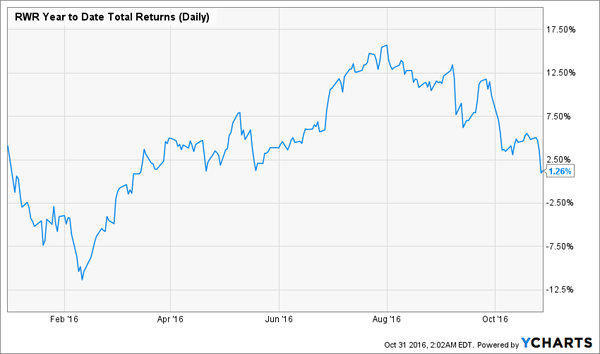
It’s a classic case of the herd falling for an old myth: that REITs underperform when interest rates rise.
The truth is, in the last rising-rate period, from July 2004 to June 2006, RWR actually gained 44%. And either way, this time around we’re not going to see rate hikes anywhere near as steep as we did back then.
The bottom line? The latest pullback has served up a terrific buying opportunity. In fact, we can now buy RWR for less than we could buy the index at the beginning of the year! This is great news for income investors.
There’s just one problem: a lot of the REITs RWR holds are still overvalued.
This is the nature of index funds; you’re getting the whole sector without being picky. Passive-investing advocates claim this creates a diversified portfolio that can resist market downturns, but that’s not exactly true. You’re far better off taking a more surgical approach than blindly buying an index fund every month.
To illustrate the point, let’s build a REIT portfolio that can withstand a recession.
Yes, this is possible. Some REITs do horribly during market downturns—a recession can badly hurt triple-net lease REITs, for example. That’s because these companies depend on retail tenants who can keep paying the rent, and those tenants can only do so if they have enough shoppers trooping through the doors. When traffic drops, money gets tight—and triple-net-lease REITs run into trouble.
During the Great Recession, for example, fear of deadbeat tenants drove one of the safest and most durable REITs in the world, National Retail Properties (NNN), down over 50% in the span of a few months. NNN rents to retail behemoths like Target and Wal-Mart.
NNN: Not So Safe in a Downturn
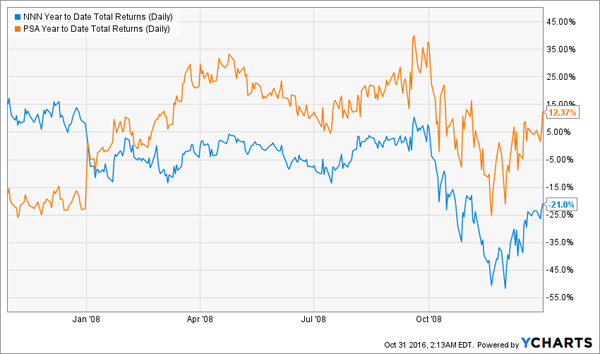
You probably noticed that in this chart I’m comparing NNN with Public Storage (PSA), one of my favorite “recession-proof” REITs. The 2008 crash hurt everyone, of course, but as you can see, PSA’s 25% decline was half that of NNN’s. In other words, this stock was much more durable in a time when everyone was terrified people would stop spending.
This makes sense—people still need storage space in good times and bad, so the recession didn’t dent PSA’s income.
And now is a great time to buy PSA. Recent weakness in the REIT sector means the stock is down more than 14% on the year, even when you include its near-4% dividend.
PSA: Weak for No Reason
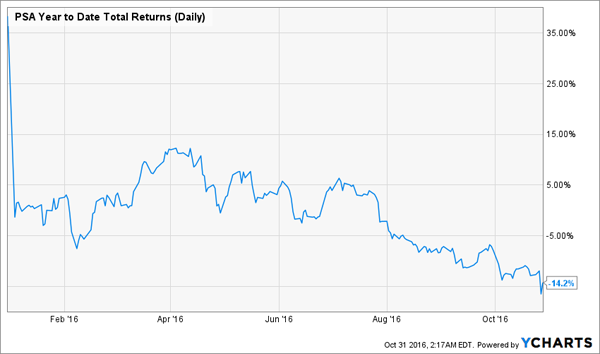
Normally when you see a drop like that, you’d expect it to be caused by some company-specific bad news. But that’s not the case here: it’s just the result of general REIT weakness following a wild few months, combined with overhyped interest-rate fears. Neither of those issues has anything to do with PSA’s cash flow, which is poised to keep growing.
2 More REITs to Put on Your Watch List—for Now
So chock up PSA as a great buy now. And get out your watch list, because I’m eyeing two other sturdy REITs closing in on a key trigger that will make them great buys in the next few weeks.
The first is Sabra Healthcare (SBRA), another REIT whose income is not damaged by recessions. This is a great high-yielder, with a 7% payout that’s set to grow thanks to the company’s continued expansion. Also, Sabra’s healthcare facilities will always have a steady stream of customers, no matter what the wider economy does.
That makes it a great recession-proof REIT—and it’s soon going to be on sale:
SBRA Begins to Correct
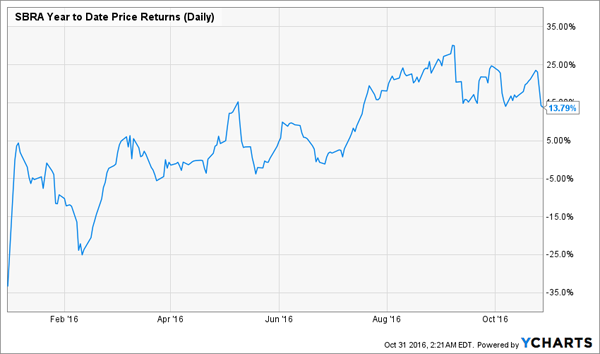
You can see that the price is down over 15% from its height a few months ago, and I’m betting it will keep correcting as the end-of-year rate hike gets closer. When SBRA is flat or down year-to-date, it will be the perfect time to buy.
Ventas Inc. (VTR) is in the exact same situation. Another healthcare REIT with steady demand, this company yields over 4% and is one of the biggest in the industry. Yet it’s quickly giving up recent gains:
VTR: A Bargain in the Making
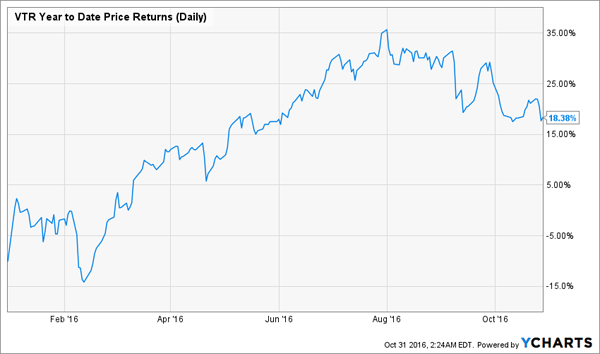
Again, we’re still up year-to-date, so it’s a bit early to jump in and buy this one. But we’re quickly approaching a flat or slightly up year-to-date price return, and that’s when this stock will be on sale and worth buying.
Here’s the takeaway: buy PSA now, then add SBRA and VTR to your watch list to buy in the coming weeks.
Safe 7% Yields From My “No-Withdrawal” Retirement Portfolio
Ventas, Sabra and Public Storage are just the type of stocks you want to own when the next panic hits. But only one—Sabra—boasts a high enough yield to let you achieve what I call the retirement “holy grail”: the ability to retire without tapping your capital.
The other two are hiking their payouts steadily, but it would still be years before you’d be yielding a sturdy 7%+ on your initial investment.
But here’s the good news: I’ve got two other recession-proof REITs for you that both yield 7% and more right now.
Both trade at greater discounts than the three names above, which is why I’m convinced they’ll soar 10% to 15% in the next year as more investors ditch their 3% to 4% payers for these reliable income generators.
In fact, these REITs are so solid that I’ve made them a cornerstone of my No-Withdrawal retirement portfolio, which is designed to let you hang it up and live on dividend income alone—and never have to sell a single share.
That’s the ultimate crash protection, because it means you won’t be forced to sell shares when the next crash hits! You can simply kick back and collect your dividend checks while you wait for the market to get back on its feet.
Most people know this is the right way to invest for retirement. What they don’t know is where to find the reliable 7%+ payers to make it happen.
